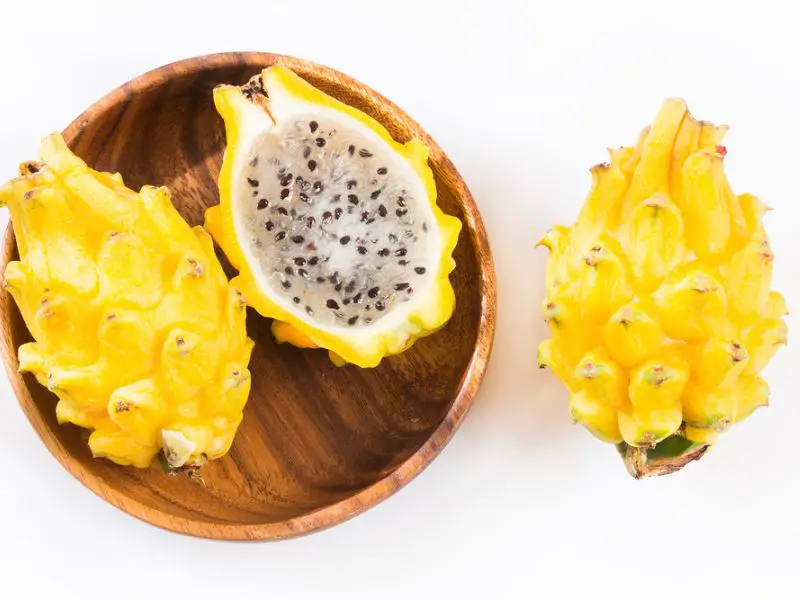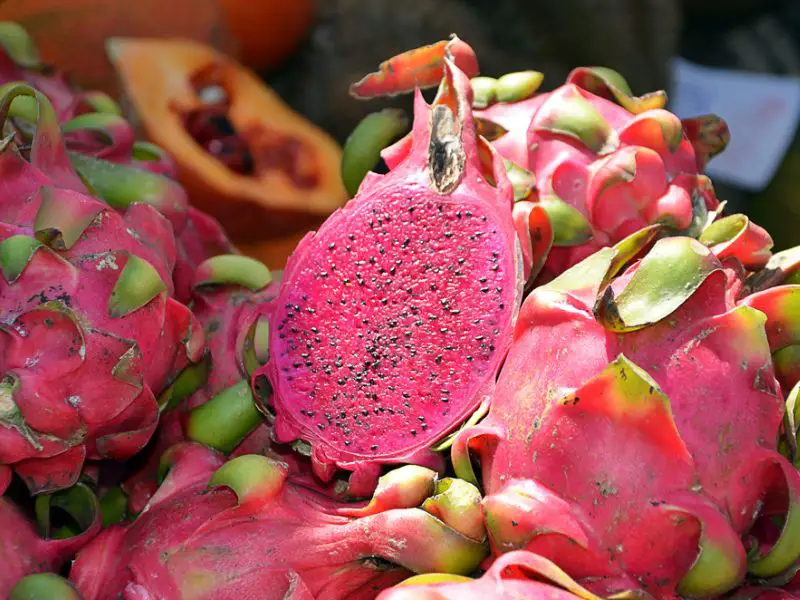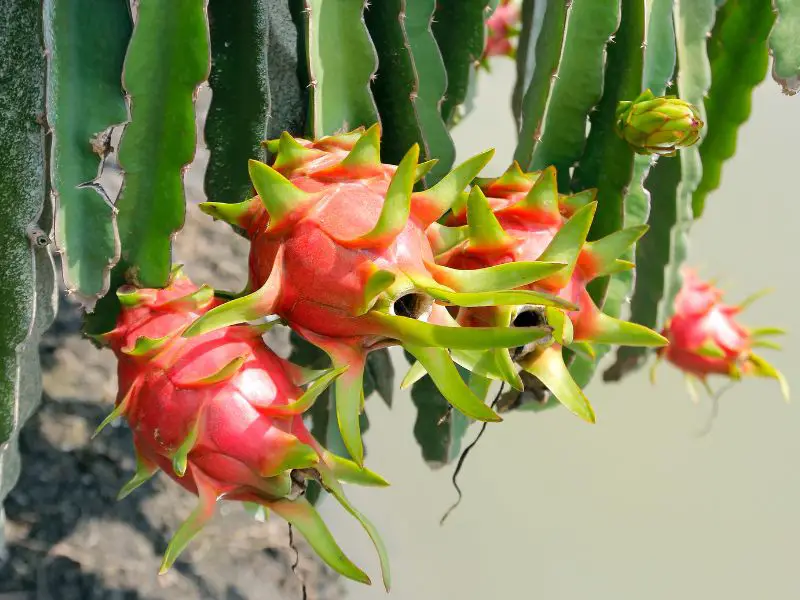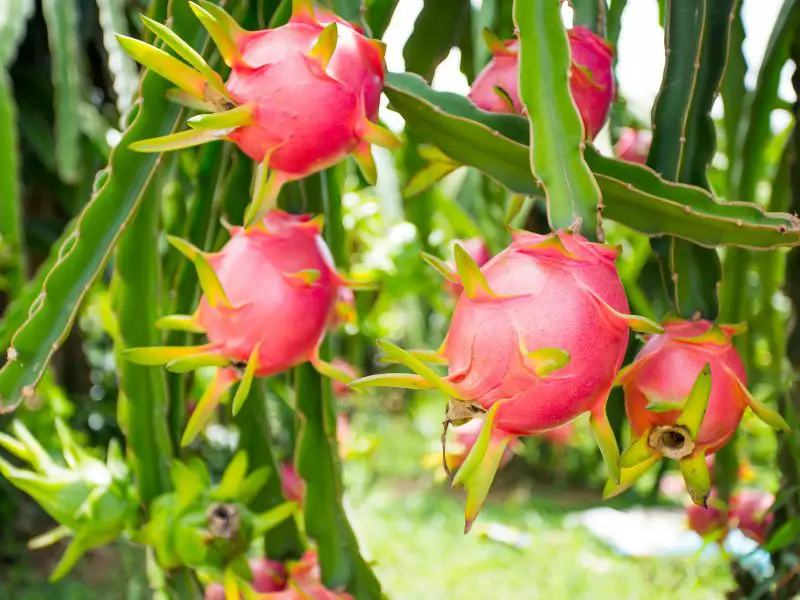Dragon fruit is an exotic fruit with a fascinating history and several health benefits. Known as pitaya or pitahaya, the fruit of the dragon plant is native to Central America, Mexico, and the Caribbean. The fruit grows on evergreen trees that reach up to 12 feet tall and 3 feet wide. The fruit has a thick outer skin and white flesh with numerous black seeds. Dragon fruit can be eaten raw or cooked and is often used in smoothies, shakes, and other blended dishes. Here’s all you need to know about growing dragon fruit.

What Is Dragon Fruit?
Dragon fruit is a fruit with white pulp, small black seeds, and bright pink skin. Commonly used in fruit salads, smoothies, and salads, each fruit weighs between 150 and 600g. It’s bit bland on flavor and closely matches the texture of kiwi fruit. To prepare, just split the fruit in half and remove the flesh with a spoon.
Dragon fruit may seem strange at first glance, but it tastes and feels very much like other tropical fruits. If you can eat kiwi fruit, you are already familiar with eating dragon fruit.
Varieties of a Dragon Fruit
There are a few different kinds of dragon fruit, but these are the most common ones:
Hylocereus Undatus
This variety is known for its vivid pink, leathery exterior, delicious white flesh, and tiny black seeds.
Hylocereus Megalanthus
This dragon fruit is hard to find and has sweet white fruit inside a yellow, thorny shell.

Hylocereus Costaricensis
This fruit’s shell and flesh are a vibrant shade of red. The flesh has a shade of intense crimson, giving it a blood-like appearance. As its name indicates it mostly grows in Central America, in Costa Rica specifically.

How To Grow Dragon Fruit in Pots
Unlike other cactus plants, dragon fruit climbs and needs a little help to grow right. It’s a subtropical plant that requires excellent heat and humidity. Here’s everything you need to know to care for and cultivate dragon fruit.
- Soil requirements – This plant thrives in any well-draining soil. However, it favors slightly acidic soil with a pH level between six and seven. For the best option, use sandy soil. If it is not accessible, make sure the soil is well draining.
- Fertilizer – You can use any general-purpose fertilizer made for cacti plants. Avoid using urea-based fertilizers as they can cause root rot.
- Light requirements – As with most cactus plants, dragon fruit grows best in direct sunlight. You can also grow this plant indoors under a grow light, but provide the plant with direct sunlight for most of the day for optimal growth.
- Water requirements – You want to provide this plant with lots of water while it’s young. However, you will want to gradually cut back on watering as it matures. Avoid letting the soil dry out completely and allow moderate drying between waterings.
- Repotting – Generally, succulents do not require repotting; however, as a climbing specimen, you may want to repot this plant every 2-3 years, depending on its size.
- Temperature – Dragon fruit requires temperatures to be above 40 degrees Fahrenheit. Avoid growing the plant at temperatures below 40 degrees and above 80 degrees. If your plant is young, it can tolerate temperatures between 75 and 85 degrees; however, as it matures, it will need less and less temperature variation.
What Season Dragon Fruit Grows Best?
This plant loves the heat, so growing it best is in summer. It doesn’t grow that much in other seasons, but it grows swiftly when it does. The flowers will bloom from July through October, but only for one night every year. After flowering, the fruit will sprout out. One plant may produce fruit for 20 to 30 years, so be prepared for an abundance of dragon fruit if you grow one.
What Regions Do Dragon Fruits Grow Best?
The plant is commonly grown in Asia, Mexico, and South America. They are abundant in Mexico, Vietnam, Colombia, Ecuador, Nicaragua, Thailand, Indonesia, Israel, Singapore, and Taiwan.

How To Grow Dragon Fruit From Seeds
Growing Dragon Fruit From Seeds
Growing dragon fruit from seeds requires relatively little equipment but a substantial time. Pick a dragon fruit from the local grocery store and strip away the seeds. Wash and dry the seeds overnight before planting them in damp soil. In two weeks, the seeds should sprout.
Be careful not to over-water seedlings; wait until the soil has dried out completely between waterings.
Don’t expect to have a good crop of dragon fruit straight immediately. It may take around five to seven years for a plant to grow and produce fruit. This is one reason why many people who produce dragon fruit choose to start their plants from cuttings (which will take just one to three years to start producing).
Growing Dragon Fruit From Cuttings
It’s pretty easy to start a new dragon fruit tree from a cutting. All you need is a friend with a tree, and you’re good to go. Cut a 30-cm piece of a dragon fruit tree and let it dry for 5–6 days, or until the end where you trimmed it turns white.
When it got dry, put the cut side down the solid and water once a month. Within a month, your plant will begin to form roots and establish itself in its new environment. After that, it will continue to flourish. Simple as that!
With this method, you’ll have to wait between one and three years for fruit.
Growing Dragon Fruit From Pots
It’s a good idea to grow dragon fruit in pots, especially if you live in warm places. When conditions are right, dragon fruit plants can grow tall and grow aerial roots. Look for a pot that is about 250mm deep and 600mm wide when choosing one. Fill it with good cactus soil that is a little sandy and a little bit acidic.
Dragon fruit plants climb, so give them something to climb on, like a stake or trellis.
Growing Dragon Fruit Outdoors
Some owners grow dragon fruit in their backyards. Not only does it pack delicious fruit, but this plant is also aesthetic in gardens. To start planting, clear the area of any weeds and pebbles. Cultivate the soil to be sandy and suitable acidic pH. To make the bed more cactus-resistant, add a little potting mix to it.
As your dragon fruit plant matures, invest in a trellis or position it beside a fence or anything it can climb on; however, keep in mind that they are heavy plants and must be able to maintain the plant weight while it is producing fruit.
Harvesting Dragon Fruit
Dragon fruit is related to cactus, although it is not a cactus. Dragon fruit has a spiky exterior which, when harvested, often gets stuck in people’s fingers and clothing, so it’s best to wear long sleeves and sturdy pants. Though it is relatively simple to harvest dragon fruit, one important thing to consider: its fruit is on its way when the plant starts flowering. Once fruit shows, it needs around four weeks to reach full ripeness. When the fruit’s skin turns brightly pink, you’ll know it’s ready to eat.

Author’s Note
Dragon fruit is a treat to the palate and a nutritional powerhouse, with only 1 cup of dragon fruit providing 11% of your daily vitamin C needs. With all of the vitamin C, antioxidants, and fiber, Dragon fruit is an ideal fruit to enjoy for breakfast or as part of a fresh and healthy… and tasty – lunch.
Dragon fruit is a nutrient-packed fruit that offers a range of health benefits. Learn more about this exotic fruit and explore tasty recipes in this guide. You can live a healthier life by following these eco-friendly tips: Healthy Beverages, Healthy Sweet Snacks, Worst Fruits for the Environment


2 thoughts on “A Beginner’s Guide to Growing Dragon Fruit”